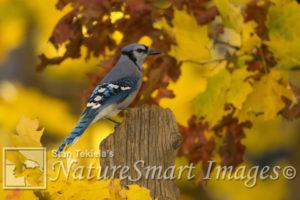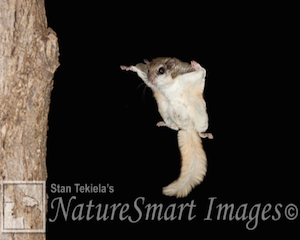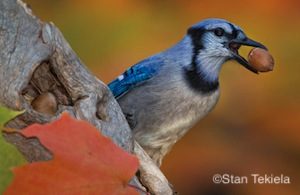
About Blue Jays, Flying Squirrels, and Chipmunks
 In today’s post, Stan Tekiela, naturalist and wildlife photographer, observes Blue Jays, flying squirrels, and chipmunks as they prepare for winter.
In today’s post, Stan Tekiela, naturalist and wildlife photographer, observes Blue Jays, flying squirrels, and chipmunks as they prepare for winter.
Off in the distance I can hear the familiar scream-like call of a Blue Jay. The sound pierces through the yellow and orange autumn maple leaves on a crisp blue-sky day. I sit enjoying the sunshine, calm winds, and the smell of autumn in the air.
Again, I hear the Blue Jay cry, this time a bit closer. Knowing the biology of these birds, I understand it won’t be just one bird traveling alone. No, it will be a family of Blue Jays—often two mated adult birds and several juvenile birds. Funny thing is, the Blue Jays all look exactly the same. They act the same and sound the same, so it’s impossible to tell them apart.

Looking around, I can’t help but notice all the other critters prepping for winter. Gray Squirrels are busy collecting and burying nuts and seeds. Chipmunks are stuffing their cheeks full of seeds to transport back to their underground storage chambers to eat later when snow blankets the land. Each evening my family of flying squirrels zips out of the darkness to stock up on all the peanuts I put out for them.
After the flying squirrels land, they race around grabbing one nut at a time. They are so small they can’t carry more than one peanut at a time. They run up my 80-foot-tall oak tree like a bolt of lightning, stopping only momentarily to launch themselves off into the dark night sky. Often times they fly over the top of my house, landing in the tall oaks in my backyard. I spend a lot of time watching and studying my flying squirrels.

While my mind drifts to thinking about my flying squirrels, the family of Blue Jays flies nearby and announces their arrival with a different call. This call is a pitch-perfect imitation of a Cooper’s Hawk, which sends all the smaller birds in the area fleeing in fear for their lives. If I hadn’t seen the Blue Jays, I would have thought a Cooper’s Hawk was giving this call.
The Blue Jay (Cyanocitta cristata) is a common bird of the eastern and central part of the country. They are so common that I think they often go unnoticed by the average person. But did you know that they are some of the smartest birds? They are closely related to crows and ravens. They form a complex social system, with families staying together over long periods of time. The young from last year often help raise the young from this year.
Blue Jays are credited with helping to quickly spread the growing range of oak trees after the last glacial period. The jays’ propensity for acorns and their habit of burying acorns for later consumption has led to the expansion of many species of oak tree. Recent studies show that Blue Jays carry acorns farther away from parent trees than squirrels and chipmunks.
 Different studies show that Blue Jays remember where they hide hundreds of acorns, and they retrieve a surprisingly high number of the buried nuts. The small percentage of unfound acorns, of course, sprout and produce new oak trees.
Different studies show that Blue Jays remember where they hide hundreds of acorns, and they retrieve a surprisingly high number of the buried nuts. The small percentage of unfound acorns, of course, sprout and produce new oak trees.
It was always believed that Blue Jays didn’t migrate. However, thousands are seen migrating in small family units and flocks along the upper Great Lakes each autumn. I have seen it time and time again myself. But where these birds are going is still unknown. In some smaller studies, it seems that some birds will migrate in some years and not in other years. No one seems to know what is going on with the migrating jays, showing us yet again we really don’t understand nature at all.
If you enjoyed Stan’s post, you may consider one of his amazing nature books: Majestic Eagles; The Lives of Wolves, Coyotes, and Foxes; or Backyard Birds: Welcomed Guests at our Gardens and Feeders. Young readers will delight in his award-winning children’s books, such as Whose Butt?, Critter Litter, and his latest, Jump, Little Wood Ducks.
You can follow Stan on Facebook and Twitter, or contact him via his web page. Stan’s nationally syndicated NatureSmart Column appears in more than 25 cities spanning 5 states (Minnesota, Wisconsin, Michigan, Illinois, and Pennsylvania) and is circulated to more than 750,000 readers. Stan’s author page on Amazon features some amazing videos! Check them out, and follow him for updates.
For more stories about wildlife and nature, sign up for our newsletter now!
More posts from Stan:
Indigo Bunting—A Familiar Summer Visitor
The Nesting Behaviors of Sandhill Cranes
Big Birds, Baby Birds, Birds Everywhere
Stan Tekiela observes Marsh Wrens
The Magical, Mystical World of Sandhill Cranes


